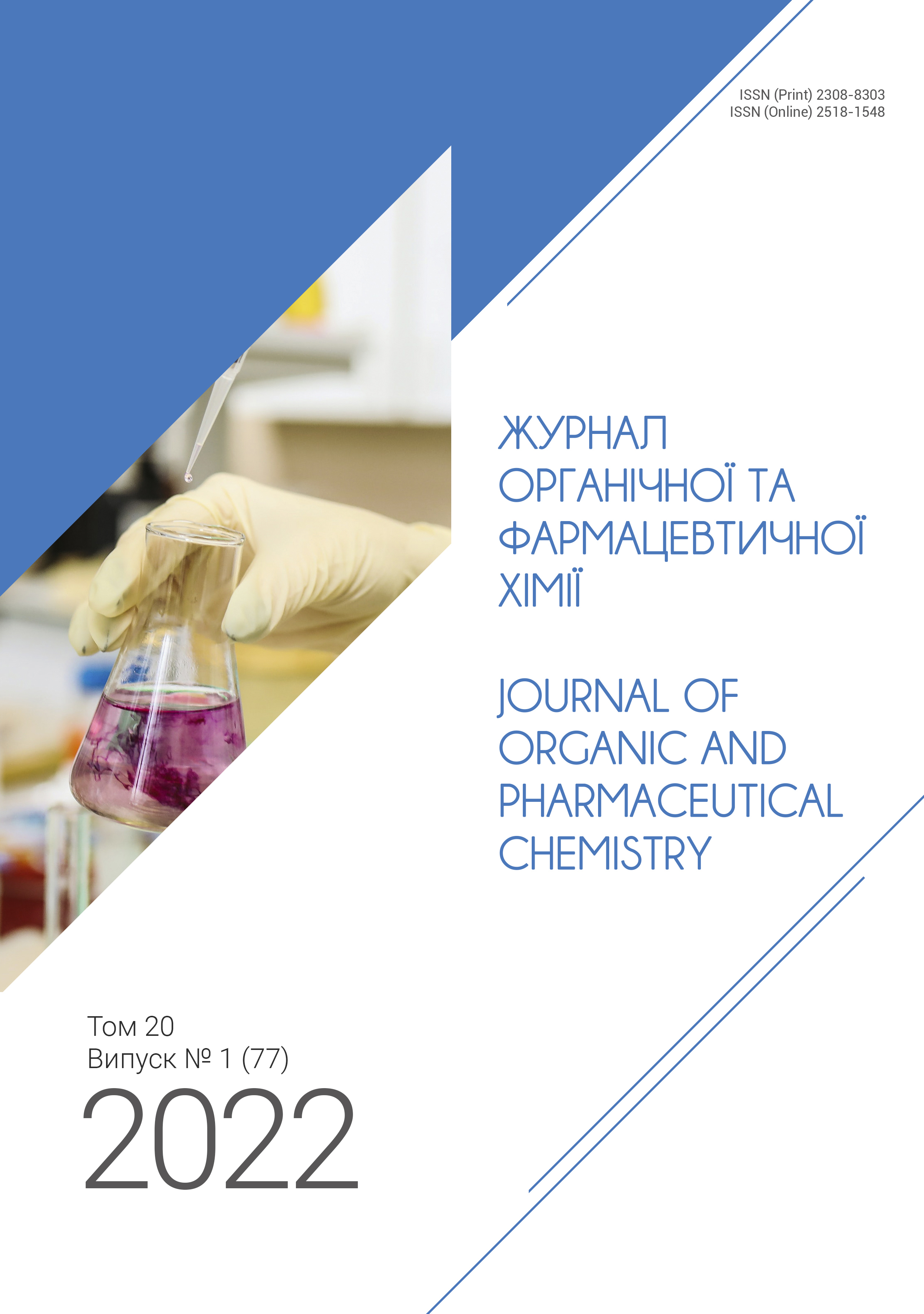The quantitative determination of glutathione by the effect of the chemiluminescence inhibition in the catalytic oxidation reaction of luminol with hydrogen peroxide in the presence of hemoglobin
DOI:
https://doi.org/10.24959/ophcj.22.255967Keywords:
glutathione, chemiluminescence inhibition, quantification, luminolAbstract
Aim. To develop a method for the quantitative determination of reduced glutathione in a lyophilized powder for the preparation of “Hepaval®” solution for intravenous and intramuscular administration by the effect of inhibiting chemiluminescence in the luminol (H2L)–Н2О2–hemoglobin (Hb) system.
Materials and methods. The study object was the reduced glutathione substance and lyophilized powder for the preparation of “Hepaval®” solution for injection, ampoules of 4 mL No. 10 manufactured by “Valartin pharma” (Italy). The glutathione content in powder was determined using the chemiluminescence method by the effect of inhibiting the luminol oxidation reaction with hydrogen peroxide in the presence of Hb as a catalyst. The analysis was performed by the standard addition method.
Results and discussion. As a result of the studies, it has been found that under optimal conditions glutathione shows a noticeable inhibitory effect on chemiluminescence in the H2L–H2O2–Hb system. This phenomenon was used to develop a new procedure for the quantitative determination of glutathione in the substance and lyophilized powder for the preparation of “Hepaval®” aqueous solution for injection. The linear dependence of the integral chemiluminescence intencity (S) on the molar concentration of glutathione was maintained in the concentration range of (2 – 20) × 10–7 mol L-1. The graph equation was S = (–1.6 ± 0.2) × 107 × c + (198.9 ± 2.0), (r = 0.999). The relative standard deviation (RSD) was ±1.82 % (n = 7, P = 0.95).
Conclusions. The method has been developed, and the possibility of the quantitative determination of glutathione in powder for the preparation of “Hepaval®” solution for injection by the method of the chemiluminescence inhibition of the H2L–Н2О2–Нb system has been shown. The content of glutathione in powder calculated with reference to dried substance was 91.49 % (against 90.8 % by the certificate). The accuracy was +0.76 %.
Supporting Agency
- The work is a part of the research of the National University of Pharmacy on the topic “Organic synthesis and analysis of biologically active compounds, drug development based on synthetic substances” (the state registration No. 01144000943; the research period 2019 – 2024).
Downloads
References
- Pompella, A.; Visvikis, A.; Paolicchi, A.; Tata, V. D.; Casini, A. F. The changing faces of glutathione, a cellular protagonist. Biochem. Pharmacol. 2003, 66 (8), 1499-1503. https://doi.org/10.1016/S0006-2952(03)00504-5.
- He, Y.; Zhou, C.; Huang, M.; Tang, C.; Liu, X.; Yue, Y.; Diao, Q.; Zheng, Z.; Liu, D. Glyoxalase system: A systematic review of its biological activity, related-diseases, screening methods and small molecule regulators. Biomedicine & Pharmacotherapy 2020, 131, 110663. https://doi.org/10.1016/j.biopha.2020.110663.
- Grant, C. M. Role of the glutathione/glutaredoxin and thioredoxin systems in yeast growth and response to stress conditions. Mol. Microbiol. 2001, 39 (3), 533-541. https://doi.org/10.1046/j.1365-2958.2001.02283.x.
- Kerksick, C.; Willoughby, D. The Antioxidant Role of Glutathione and N-Acetyl-Cysteine Supplements and Exercise-Induced Oxidative Stress. Journal of the International Society of Sports Nutrition 2005, 2 (2), 38. https://doi.org/10.1186/1550-2783-2-2-38.
- Hayes, J. D.; Flanagan, J. U.; Jowsey, I. R. Glutathione Transferases. Annu. Rev. Pharmacool. Toxicol. 2005, 45 (1), 51-88. https://doi.org/10.1146/annurev.pharmtox.45.120403.095857.
- Ellman, G. L. Tissue sulfhydryl groups. Arch. Biochem. Biophys. 1959, 82 (1), 70-77. https://doi.org/10.1016/0003-9861(59)90090-6.
- Dutov, A. A.; Nikitin, D. A.; Fefelova, E. V.; Mishchenko, M. N.; Semenova, A. N.; Sverkunova, A. V.; Martynova, A. V.; Luk'yanova, Yu. L.; Ermolina, A. V. VEZhKh-analiz cisteina, gomocisteina i glutationa v slyune [HPLC analysis of cysteine, homocysteine and glutathione in saliva, in Russian]. Problems of biological, medical and pharmaceutical chemistry 2014, 7, 29-32.
- Perevezenceva, D. O.; Gorchakov, E. V. Vol'tamperometricheskoe opredelenie glutationa s ispol'zovaniem grafitovyh elektrodov, modifitsirovannyh nanochasticami zolota [Voltammetric Determination of Glutathione Using Graphite Electrodes Modified with Gold Nanoparticles, in Russian]. Zavodskaya laboratoriya. Diagnostika materialov 2015, 81 (7), 24-27.
- Chaichi, M. J.; Ehsani, M.; Khajvand, T.; Golchoubian, H.; Rezaee, E. Determination of cysteine and glutathione based on the inhibition of the dinuclear Cu(II)-catalyzed luminol–H2O2 chemiluminescence reaction. Spectrochim. Acta, Part A 2014, 122, 405-410. https://doi.org/10.1016/j.saa.2013.10.105.
- Khajvand, T.; Chaichi, M. J.; Colagar, A. H. Effects of glutathione, l-cysteine, and l-methionine on the kinetics and mechanism of the peroxyoxalate–rubrene–H2O2 chemiluminescence system. Reaction Kinetics, Mechanisms and Catalysis 2015, 116 (1), 51-61. https://doi.org/10.1007/s11144-015-0878-4.
- Waseem, A.; Yaqoob, M.; Nabi, A. Analytical Applications of Flow Injection Chemiluminescence for the Determination of Pharmaceuticals – A Review. Current Pharmaceutical Analysis 2013, 9 (4), 363-395. http://dx.doi.org/10.2174/15734129113099990002.
- Adcock, J. L.; Barnett, N. W.; Barrow, C. J.; Francis, P. S. Advances in the use of acidic potassium permanganate as a chemiluminescence reagent: A review. Anal. Chim. Acta 2014, 807, 9-28. https://doi.org/10.1016/j.aca.2013.11.016.
- British Pharmacopoeia; The Stationery Office: London, 2018 (electronic edition).
- 14. Bondarenko, N. Yu.; Blazheyevskiy, M. Ye. Determination of N-Acetylcysteine in Tablets by Means of Chemiluminescence Inhibition Method. Methods and objects of chemical analysis 2018, 13 (3), 110-114. https://doi.org/10.17721/moca.2018.110-114.
Downloads
Published
How to Cite
Issue
Section
License
Copyright (c) 2022 National University of Pharmacy

This work is licensed under a Creative Commons Attribution 4.0 International License.
Authors publishing their works in the Journal of Organic and Pharmaceutical Chemistry agree with the following terms:
1. Authors retain copyright and grant the journal the right of the first publication of the work under Creative Commons Attribution License allowing everyone to distribute and re-use the published material if proper citation of the original publication is given.
2. Authors are able to enter into separate, additional contractual arrangements for the non-exclusive distribution of the journal’s published version of the work (e.g., post it to an institutional repository or publish it in a book) providing proper citation of the original publication.
3. Authors are permitted and encouraged to post their work online (e.g. in institutional repositories or on authors’ personal websites) prior to and during the submission process, as it can lead to productive exchanges, as well as earlier and greater citation of published work (see The Effect of Open Access).















